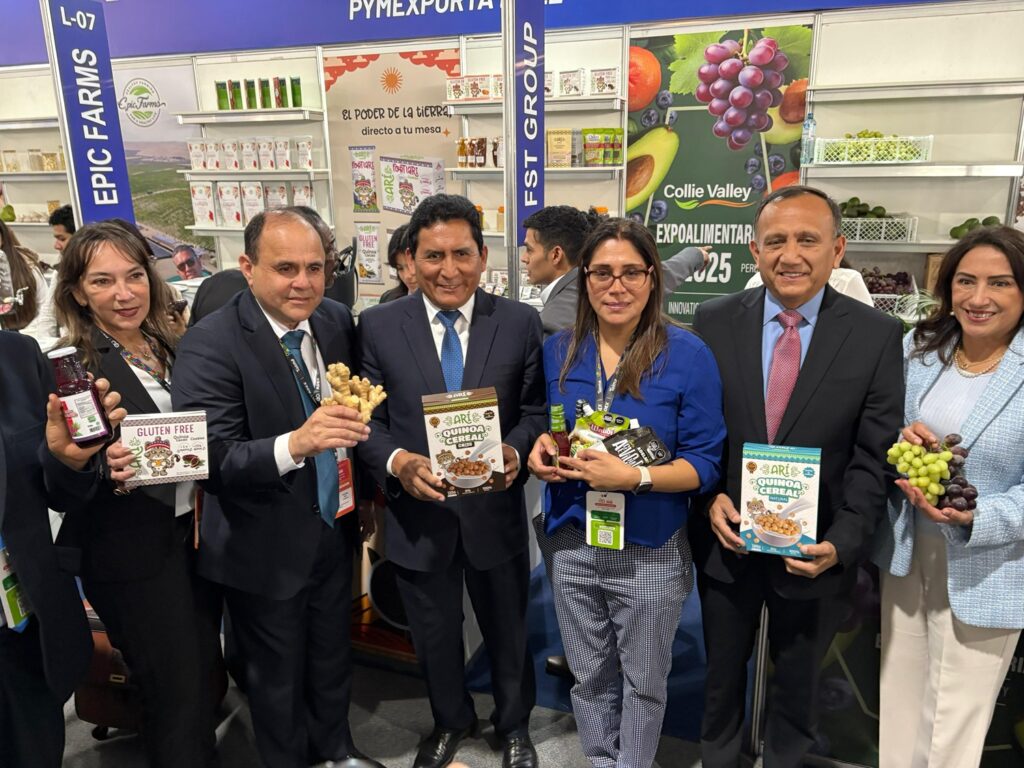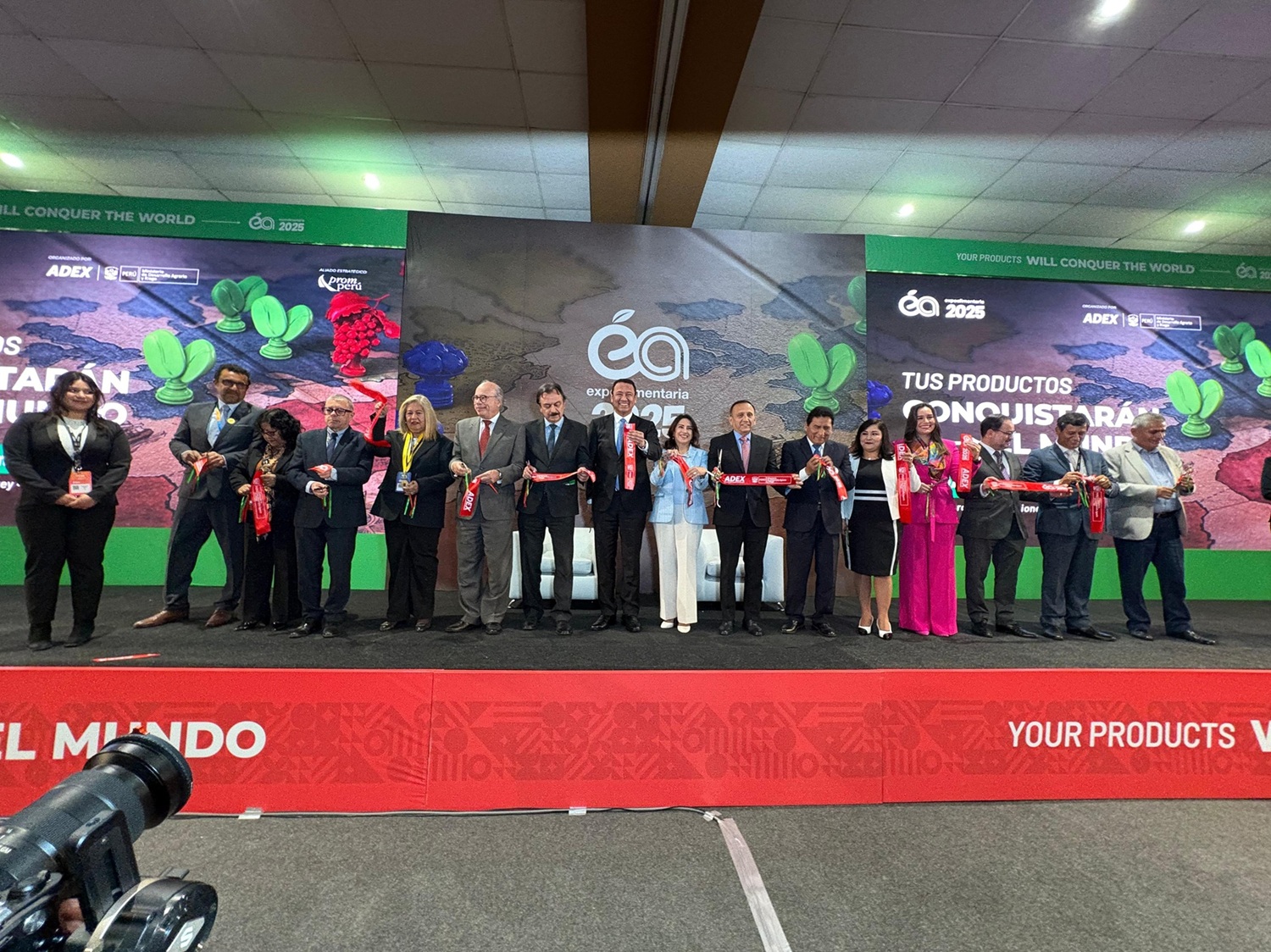Agencia Peruana de Noticias PRENSAPERU.PE https://prensaperu.pe/ Twitter: @prensaperupe Durante la inauguración de la Expoalimentaria 2025, el presidente de la Asociación de Exportadores (ADEX), César Tello Ramírez, proyectó un futuro promisorio para las agroexportaciones peruanas. Impulsado por la reciente Ley Agraria, una mayor apertura comercial, y proyectos estratégicos de envergadura como el puerto de Chancay, la modernización del aeropuerto Jorge Chávez, el establecimiento de Zonas Económicas Especiales Privadas (ZEEP) y la implementación de una robusta infraestructura hídrica, el Perú se encuentra en una posición privilegiada para alcanzar los US$ 15 mil millones en agroexportaciones en el corto plazo.
En una ceremonia que congregó al ministro de Agricultura, Ángel Manero Campos; la viceministra de Comercio Exterior del Ministerio de Comercio Exterior y Turismo, Teresa Mera Gómez; se destacó la relevancia de este evento internacional en el dinamismo del sector.
Tello Ramírez resaltó el impacto significativo de Expoalimentaria en el crecimiento del sector. “Desde la primera edición de Expoalimentaria en 2009 hasta el 2024, las agroexportaciones peruanas, tanto tradicionales como no tradicionales, experimentaron un notable ascenso, pasando de US$ 2 mil 425 millones a US$ 12 mil 369 millones”, subrayó.
A pesar de estos logros, Tello Ramírez enfatizó la necesidad de intensificar los esfuerzos para integrar a los productores y agricultores de la sierra y la selva en la dinámica del comercio exterior. En este contexto, la nueva Ley Agraria se vislumbra como un catalizador fundamental para un segundo auge agroexportador.
“Este progreso solo se materializará a través de un esfuerzo colaborativo. Desde el sector privado, reafirmamos nuestro compromiso de capitalizar cada oportunidad para fortalecer nuestra competitividad, diversificar nuestros productos y mercados, y consolidar al Perú como un proveedor global confiable de alimentos. Para lograrlo, necesitamos estabilidad, predictibilidad, seguridad y una infraestructura adecuada que nos permita competir en igualdad de condiciones con nuestros competidores internacionales”, afirmó.
Se anticipa que este crecimiento impactará positivamente en la generación de empleo formal y descentralizado. En el 2024, las agroexportaciones generaron aproximadamente 800 mil empleos directos. “En un mundo con una población que supera los 8 mil millones de habitantes y una creciente demanda de alimentos, el Perú tiene la oportunidad histórica de posicionarse como un actor estratégico en la seguridad alimentaria global”, añadió Tello Ramírez.
UNA PERSPECTIVA GLOBAL
El representante del gremio destacó que la apertura comercial, en sinergia con el esfuerzo de los productores y empresarios, ha consolidado al país como un proveedor clave a nivel mundial de ciertos alimentos. Perú se destaca como el primer exportador mundial de arándanos y uvas, el segundo en paltas, el quinto en mangos y el sexto en café.
“Esta mayor integración nos permite acceder a nuevas tecnologías, conquistar nuevos destinos y ampliar nuestros horizontes. En un país de más de 34 millones de habitantes, el comercio global no es simplemente una estrategia, sino una necesidad vital, un camino que nos impulsa a innovar, generar empleo y reducir la pobreza”, explicó.
Tello Ramírez instó al Estado a fortalecer la red de acuerdos comerciales, resaltando la modernización del TLC con China y la finalización de las negociaciones con Hong Kong e Indonesia. Además, solicitó la inclusión de otros mercados como la India y los Emiratos Árabes Unidos. Subrayó la importancia de fortalecer el Senasa, la institución encargada de superar las barreras sanitarias que limitan el acceso de los productos peruanos a nuevos mercados.
Avanzar en esta dirección fortalecerá la competitividad y ampliará los beneficios del comercio exterior a nivel nacional. “Cada esfuerzo por abrir mercados, diversificar la canasta agroexportadora y sumar regiones al mapa exportador se traduce en más inversión y más oportunidades para los peruanos. Sigamos trabajando juntos para transformar el país que tenemos en el Perú que soñamos”, concluyó.
EXPOALIMENTARIA 2025
Esta edición de la feria contará con la participación de empresas de diversas regiones del país, presentando ofertas innovadoras y de alta calidad. Los gobiernos regionales de Cajamarca, Huánuco, San Martín, Junín, Piura y Arequipa tendrán pabellones propios para exhibir la oferta de sus empresas y productores.
En el pabellón ‘Pymexporta’, las pequeñas empresas mostrarán lo mejor de su portafolio, incluyendo paltas, mandarinas, uvas, granadas, lúcuma, snacks naturales, granos andinos, chocolates, café, salsas y aderezos.
Además, se contará con la presencia de representantes de empresas de los cinco continentes, junto con pabellones internacionales de Argentina, Brasil, Ecuador, Paraguay e Indonesia. Expoalimentaria 2025 espera recibir a más de 1 500 visitantes internacionales.
Finalmente, el evento cuenta con el patrocinio de Talma Servicios Aeroportuarios, Kikko Corporation, Universidad de Lima, Nunatura, Dinet, Agrorum, Solgas, Consorcio Eléctrico de Villacuri, Cold Import, Universidad Privada del Norte, Absorpro, Fequsa Ings., Concesionaria Interoceánica Sur Tramo 3, AB Sciex, Owens-Illinois Perú, Seidlitz Chile, Cenfrico, Alfosac, United Cargo Company, Interbank, Thermofisher, Proyecto Ventanilla y Evergreen.
CONCLUSIONES
1.- Perspectivas de Crecimiento.
La Expoalimentaria 2025 destaca el potencial del Perú para alcanzar los US$ 15 mil millones en agroexportaciones gracias a la nueva Ley Agraria, la apertura comercial y proyectos estratégicos.
2.- Impacto Económico y Social.
El evento subraya la importancia de integrar a los productores de la sierra y la selva en el comercio exterior, lo que impulsará la generación de empleo y la reducción de la pobreza.
3.- Posicionamiento Global.
La feria reafirma el papel del Perú como un proveedor clave de alimentos a nivel mundial y la necesidad de fortalecer los acuerdos comerciales y superar las barreras sanitarias para seguir expandiendo su presencia en los mercados internacionales.
Fuente: Agencia Peruana de Noticias PRENSAPERU.PE https://prensaperu.pe/ Twitter: @prensaperupe

English Translation
Expoalimentaria 2025: “A new agrarian law and strategic projects, with the integration of the highlands and jungle, will be key to Peru’s second agro-export boom.”
Peruvian News Agency PRENSAPERU.PE https://prensaperu.pe/ Twitter: @prensaperupe During the inauguration of Expoalimentaria 2025, the president of the Association of Exporters (ADEX), César Tello Ramírez, projected a promising future for Peruvian agro-exports. Boosted by the recent Agrarian Law, greater trade liberalization, and major strategic projects such as the Chancay port, the modernization of Jorge Chávez Airport, the establishment of Private Special Economic Zones (ZEEP), and the implementation of a robust water infrastructure, Peru is in a privileged position to reach US$15 billion in agricultural exports in the short term.
At a ceremony attended by the Minister of Agriculture, Ángel Manero Campos, and the Vice Minister of Foreign Trade of the Ministry of Foreign Trade and Tourism, Teresa Mera Gómez, the importance of this international event in the dynamism of the sector was highlighted.
Tello Ramírez highlighted the significant impact of Expoalimentaria on the sector’s growth. “From the first edition of Expoalimentaria in 2009 to 2024, Peruvian agricultural exports, both traditional and non-traditional, experienced a notable increase, rising from US$2.425 billion to US$12.369 billion,” he emphasized.
Despite these achievements, Tello Ramírez emphasized the need to intensify efforts to integrate producers and farmers from the mountains and jungle into the dynamics of foreign trade. In this context, the new Agrarian Law is seen as a fundamental catalyst for a second agro-export boom.
“This progress will only materialize through a collaborative effort. From the private sector, we reaffirm our commitment to capitalize on every opportunity to strengthen our competitiveness, diversify our products and markets, and consolidate Peru as a reliable global food supplier. To achieve this, we need stability, predictability, security, and adequate infrastructure that allows us to compete on equal terms with our international competitors,” he stated.
This growth is anticipated to have a positive impact on the creation of formal and decentralized employment. By 2024, agricultural exports will generate approximately 800,000 direct jobs. “In a world with a population exceeding 8 billion and a growing demand for food, Peru has a historic opportunity to position itself as a strategic player in global food security,” added Tello Ramírez.
A GLOBAL PERSPECTIVE
The union representative emphasized that trade liberalization, in synergy with the efforts of producers and entrepreneurs, has consolidated the country as a key global supplier of certain foods. Peru stands out as the world’s leading exporter of blueberries and grapes, second in avocados, fifth in mangoes, and sixth in coffee.
“This greater integration allows us to access new technologies, conquer new destinations, and broaden our horizons. In a country of more than 34 million inhabitants, global trade is not simply a strategy, but a vital necessity, a path that drives us to innovate, generate employment, and reduce poverty,” he explained.
Tello Ramírez urged the State to strengthen the network of trade agreements, highlighting the modernization of the FTA with China and the completion of negotiations with Hong Kong and Indonesia. He also requested the inclusion of other markets such as India and the United Arab Emirates. He emphasized the importance of strengthening Senasa, the institution responsible for overcoming the sanitary barriers that limit Peruvian products’ access to new markets.
Moving forward in this direction will strengthen competitiveness and expand the benefits of foreign trade nationwide. “Every effort to open markets, diversify the agro-export basket, and add regions to the export map translates into more investment and more opportunities for Peruvians. Let’s continue working together to transform the country we have into the Peru we dream of,” he concluded.
EXPOALIMENTARIA 2025
This edition of the fair will feature the participation of companies from various regions of the country, presenting innovative and high-quality offerings. The regional governments of Cajamarca, Huánuco, San Martín, Junín, Piura, and Arequipa will have their own pavilions to showcase the offerings of their companies and producers.
In the “Pymexporta” pavilion, small businesses will showcase the best of their portfolios, including avocados, mandarins, grapes, pomegranates, lucuma, natural snacks, Andean grains, chocolates, coffee, sauces, and dressings.
In addition, representatives from companies from five continents will be present, along with international pavilions from Argentina, Brazil, Ecuador, Paraguay, and Indonesia. Expoalimentaria 2025 expects to welcome more than 1,500 international visitors.
Finally, the event is sponsored by Talma Airport Services, Kikko Corporation, University of Lima, Nunatura, Dinet, Agrorum, Solgas, Villacuri Electric Consortium, Cold Import, Universidad Privada del Norte, Absorpro, Fequsa Ings., Concesionaria Interoceánica Sur Tramo 3, AB Sciex, Owens-Illinois Perú, Seidlitz Chile, Cenfrico, Alfosac, United Cargo Company, Interbank, Thermofisher, Ventanilla Project, and Evergreen.
CONCLUSIONS
1.- Growth Prospects.
Expoalimentaria 2025 highlights Peru’s potential to reach US$15 billion in agricultural exports thanks to the new Agrarian Law, trade liberalization, and strategic projects.
2.- Economic and Social Impact.
The event underscores the importance of integrating producers from the mountains and jungle into foreign trade, which will boost job creation and reduce poverty.
3.- Global Positioning.
The fair reaffirms Peru’s role as a key global food supplier and the need to strengthen trade agreements and overcome health barriers to continue expanding its presence in international markets.
Source: Peruvian News Agency PRENSAPERU.PE https://prensaperu.pe/ Twitter: @prensaperupe
